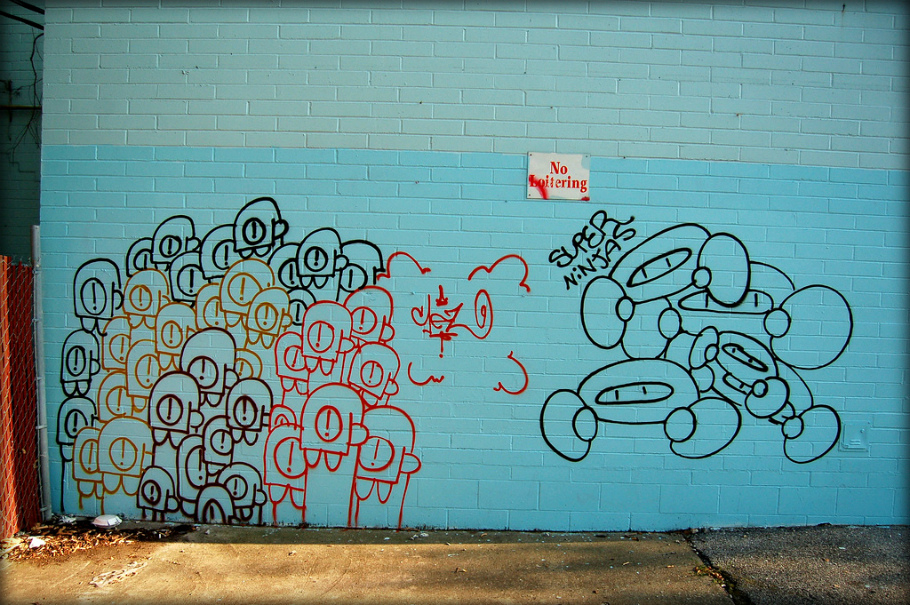
In the early days of this series, the going wisdom was that graffiti writers in town would go against their generally media-shy natures, discussing the finer points of the game, especially if offered a safe space in which to have that talk. My theory was based on the idea that even those who operate in near-to-complete anonymity would be interested in getting some of their thoughts out to the public; after all, if you’re going to write your name in a public place, you’re seemingly doing so to spark conversation.
My theory was kinda wrong. At least a few degrees off. .
Discussions have been had. In the sort of big-city-small-town moments we’ve all come to accept in St. Louis, I’ve found a few people through interesting happenstance.
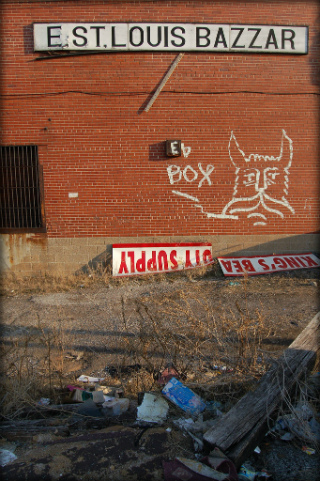 For example, I know someone who works at a local restaurant and attends an area college. This is a classic combo, the service industry being full of students, many of them very creative. In our extremely unplanned talk, I simply asked this person (who we’ll call Alex) for some background on their activities. The info was interesting and generally off-the-record, though I can share a few highlights.
For example, I know someone who works at a local restaurant and attends an area college. This is a classic combo, the service industry being full of students, many of them very creative. In our extremely unplanned talk, I simply asked this person (who we’ll call Alex) for some background on their activities. The info was interesting and generally off-the-record, though I can share a few highlights.
Alex doesn’t run with a crew, though he knows people who know people. Instead, he generally gets up only when the mood strikes; oftentimes, a little bit of alcohol goes a long way in finding that inspiration. When those evenings do hit, he usually stays around midtown and Souty City, so that he can get to-and-from locations in close proximity to his house. Occasionally, he jumps in with another artist, or two, but it’s usually either a solo affair, or one that brings in a buddy and no more. Obviously, most of the action takes place at night and much of it done traveling by foot.
Though spray paint’s involved at times, Alex likes to work with stickers and with wheat-paste posters, too. In another life, he works with a variety of artistic forms and makes part of his living artistically. The after-hours stuff? It’s not a lifestyle, not like it is for a lot of writers. It’s something to do when the mood hits, when a jolt of adrenalin’s needed. It’s been a fun thing, without a lot of repercussions so far and with work generally getting up in isolated, out-of-the-way places and spaces.
It was a good conversation. Contemporary, current. Some names were dropped, though it was mostly a talk about art, its impact and possibilities when done in odd and questionable settings.
Another discussion took place with a cat named, for the sake of this story, Aaron. Active in the late ‘90s, Aaron and his friends based their graffiti writing in the City, though they called a state other than Missouri home. When in the City, they focused a lot of attention Downtown, in what was then an unfinished Washington Avenue. A few clubs existed but the entertainment scene of today’s Wash Ave. was non-existent; during the nighttime hours on Washington, Locust and others feeder streets, life was generally quiet and the buildings were often big, accessible and offering prime real estate for getting up on prominent, visible spots.
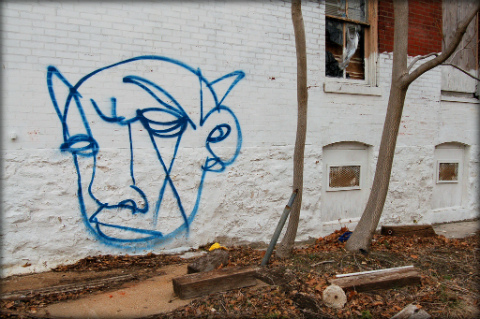 As he remembered it, there were evenings when the police would roll by, not especially worried about graffiti activities. On one memorable evening, Aaron and a couple others rappelling down the side of a major, building, on an otherwise-isolated block. He remembers seeing police under them, but no action was taken. The neighborhood was different, maybe the game was a bit different, too. It’s been years since Aaron has been active in the graffiti scene; save for an old head, or two, he doesn’t personally know the players in the community today. And, after our initial, great conversation, he’s not wanting to revisit things, at least not officially. It’s all in the past.
As he remembered it, there were evenings when the police would roll by, not especially worried about graffiti activities. On one memorable evening, Aaron and a couple others rappelling down the side of a major, building, on an otherwise-isolated block. He remembers seeing police under them, but no action was taken. The neighborhood was different, maybe the game was a bit different, too. It’s been years since Aaron has been active in the graffiti scene; save for an old head, or two, he doesn’t personally know the players in the community today. And, after our initial, great conversation, he’s not wanting to revisit things, at least not officially. It’s all in the past.
He does, though, tell me that if I look at a few buildings, at just the right, high-on angles, I can still find his name. It’s another something for the “to-do” list.
THE OFFICIAL WORD
As Alex and I speak, something’s said that’s been bubbling up in other conversations recently. It’s the idea that there’s been a crackdown on graffiti, especially in the City. This has been bouncing around for a minute, so a check-in with the St. Louis Metropolitan Police Department was surely in order.
After a couple weeks of phone and e-mail tag with the SLMPD’s media relations department, we settled upon a good time for a chat, with a solid subject offered. Sgt. Brent Feig, active in the SLMPD’s Intelligence Unit. It’s a three-pronged outfit, with a Technical Assistance Group, a Criminal Investigations Group and a Gang Enforcement Team. The latter’s role in graffiti eradication should be obvious from the name, that sector’s work squarely dedicated to stopping gang graffiti, among other gang activities. The more artistic graf falls more often under the CIG, with detectives assigned to cases, frequently based on street apprehensions.
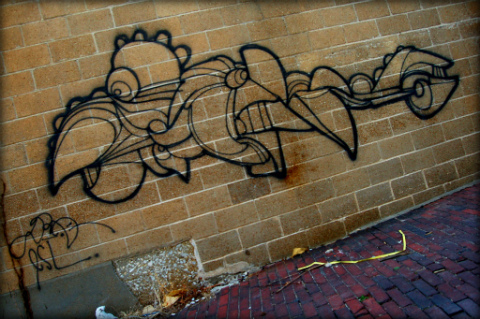 In answering some questions, Sgt. Feig’s good in detailing some of the specifics relating to the City’s anti-graffiti efforts. Attempts to get a little deeper on some specific, high-profile names, well, I have less luck there. And as far as questions that lead towards suppositions over motive, etc., these lie relatively flat, too. But the basics, yeah, let’s get to them.
In answering some questions, Sgt. Feig’s good in detailing some of the specifics relating to the City’s anti-graffiti efforts. Attempts to get a little deeper on some specific, high-profile names, well, I have less luck there. And as far as questions that lead towards suppositions over motive, etc., these lie relatively flat, too. But the basics, yeah, let’s get to them.
The biggest one is whether there’s a “task force,” as some on the streets guess.
“I don’t know of any dedicated task force that’s investigating graffiti, per se,” says Feig. “There are a number of efforts going on in the enforcement. But I don’t know of any formal ones. I think that there’s always a sharing of information through law enforcement circles. If there’s graffiti that we’re not familiar with, or don’t know the significance of, there is information that goes out to our colleagues on both sides of the river.”
If there’s no task force, could it be said that a cases against a couple of high-profile graf writers could cause either a chilling of the activity, or a pushback effort?
“A lot of investigations are ongoing and I’d probably not want to talk about pending investigations,” Feig says. “I think there are a large amount of taggers out there that we’d have to try to get our arms around. And a lot of this is a transient population.”
Media attention, Feig feels, plays only a small role in any of this.
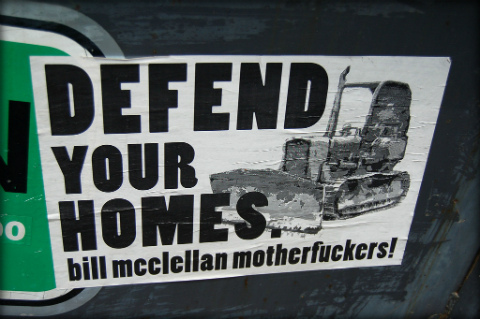 “Potentially, there’s a little bit” of extra action, Feig says. “I think Channel 2 potentially stepped up some with their coverage. One of their early morning reporters caught a tagger doing a tag on a bridge support, or railroad trestle. I think that got a bit more media attention at that time than normal. This was a single act, but with someone caught in the moment, which leads to a little more press coverage.” (story link)
“Potentially, there’s a little bit” of extra action, Feig says. “I think Channel 2 potentially stepped up some with their coverage. One of their early morning reporters caught a tagger doing a tag on a bridge support, or railroad trestle. I think that got a bit more media attention at that time than normal. This was a single act, but with someone caught in the moment, which leads to a little more press coverage.” (story link)
Finding graf writers in the act is the first step in the SLMPD’s anti-graf efforts, says Feig. That contact can be made by street officers simply finding the activity taking place, or by calls from citizens. Feig says that “direct and immediate response” comes from the beat officers, before information begins winding through the system, from that initial police report to further work by detectives.
The gang sector of the Intelligence Unit is clearly engaged in anti-graffiti efforts, though this is a very element of graffiti.
“Gang graffiti,” Feig says, “oftentimes will tell a much more purposeful message. Potential feuds with other gangs, or the identification of gang members. Sometimes, it’s a little more telling with what they saying, than on the the artistic side.”
Concurring with the information passed on by Mary Lou Green of Brightside St. Louis, Feig says that the service will be called when specific threats are conveyed. It’s something that’s requested, for example, when “potential retaliation is mentioned, over something along those lines. At times, we could ask for it. The district captains of our patrol divisions may receive calls from constituents from an area, or direct or elected officials may reach out to Brightside to remove them. It depends on neighborhood response. A number of things are taken considered in relation to our asking them to remove it.”
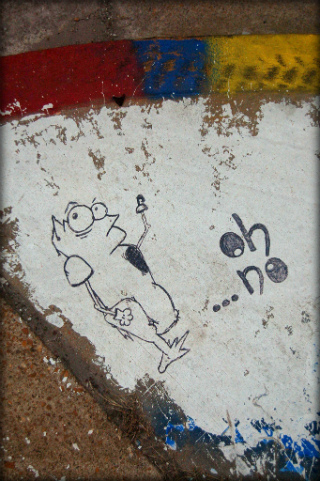 He says that gang graffiti isn’t necessarily more alarming to home- or business-owners, as “it depends on where the tag is done. Obviously, if you’re a business owner and the whole side of your building is tagged, you might have the same concerns or surprise as gang graffiti being seen somewhere else in the City.”
He says that gang graffiti isn’t necessarily more alarming to home- or business-owners, as “it depends on where the tag is done. Obviously, if you’re a business owner and the whole side of your building is tagged, you might have the same concerns or surprise as gang graffiti being seen somewhere else in the City.”
Perhaps most interesting in our conversation is the notion that, in gang terms, tagging in the traditional sense is giving way to social media. Instead of a blast of spray paint, a quick Tweet can convey some of the same meaning.
“Older gang members,” Feig says, “typically resort to tagging buildings, structures, sidewalks, anything fixed. We’re now looking at younger gang members using social media as an area to tag. I think it’s overall stagnant, as far as increases or decreases in activity. We haven’t seen much movement either way. What we are seeing is this increase in social media use.”
Still, old-school graffiti’s out there. And, to the SLMPD, it’s something that is officially needing to be addressed.
“There are some tags going on throughout the City,” Feig says. “It’s about the taggers safety and the general public’s safety. Especially when they’re on bridges, or railroad trestles, where they’re hanging out over traffic. It then becomes a safety issue. We’re always trying to stress that we’re trying to keep the taggers safe and the public safe.”
Whether those involved in graffiti writing believe the same. Well, we’ve got a couple weeks to go and open ears.
FOR FURTHER READING AND VIEWING
It’s hot out. So we’ve been a little lazy. Here are a couple odds/ends for your consideration.
Marc Ecko sponsored a documentary about. It’s relatively short and hits all the 101 issues and themes. For example, if you’re not familiar with the newbie term “toy,” this film will get you up to speed. Problem being, the version currently found on YouTube has two video drop-outs, though the audio rolls throughout:
A site called Graffittistudies? With an academic approach to coverage of Australian graffiti history? What? Don’t mind if we do.

